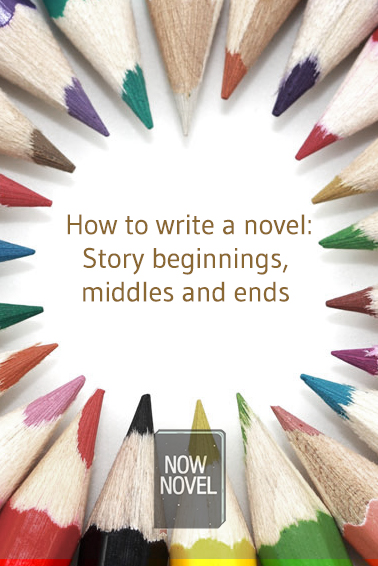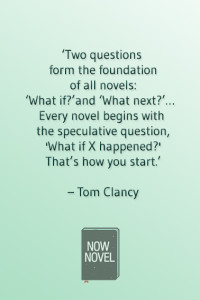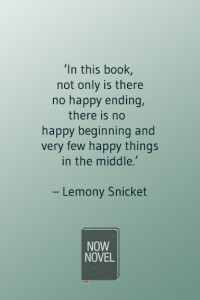Learning how to write a novel involves mastering many skills – description, narration, crafting believable characters and more. Understanding how to writing engaging story beginnings, middles and endings is also key. Here are key tips on writing each of these three important parts of a book:
1: How to write engaging novel beginnings
The beginning of a novel has several jobs to do. First, it needs to get the reader’s attention and make them want to purchase the book and keep reading it.
Secondly, it needs to establish the fictional world that is the story’s setting. It also needs to establish who the main characters are. The inciting incident that sets the main action of the novel in motion should also happen at the beginning.
This is a lot of ground to cover in just a few chapters. Furthermore, there are a number of mistakes to watch out for. Writer Natasha Lester covers some of these common errors in her blog post about beginnings. Many of the items on Lester’s ‘don’t’ list consist of passages that slow down the narrative. Avoid elements such as flashbacks, back story or dream sequences at the start of your novel.
Engaging the reader does not necessarily begin with explosive action, however. In fact, this can leave a reader cold. The problem is that action without emotional engagement is unlikely to make readers care.
What does make readers care is characters engaged in interesting dialogue. We also are reeled in by novel openings that raise questions or conjure unusual settings or situations.
You may have to revise the beginning more than any other part of your novel. Avoid the temptation to keep revising it from the start, though. There will be plenty of time to revise your novel as much as needed, but before that can be done, it needs to be finished first. That means moving on to the middle:
2: How to write a novel and steer clear of the muddy middle
As Lemony Snicket, the alter-ego of writer Daniel Handler, points out, the middle is where very little good happens to main characters. If the characters are too uncomplicated, straightforward and happy, the story lacks conflict, and a story without conflict is not very interesting to read. Insufficient conflict is one source of muddy middles where the pace slackens.
Ideally, the middle is the heart of the story, where almost all of the important events of the novel happen. It comprises at least 50 percent of the novel if not more. However, it is also the place where writers tend to lose their momentum and the story falters.
The middle of the book is where many novels lose their narrative drive. This is often due to poor structure.
If you’re a pantser, you might not work on story structure as much as a seasoned plotter. Problems arise for planners when they do not develop an effective structure in their outline. Problems arise for pantsers when they have not developed an intuitive sense of good structure in their story conceptualizing process.
Too often, the middle of the novel meanders with a series of events that are not connected clearly enough to the novel’s inciting incident and climax. One thing you should ask yourself during the planning stage (or if in a mid-novel crisis) is whether the events in the middle follow from one to another believably and (particularly in the case of thrillers and other tension-dependent genres) increase the tension by raising the stakes. A good story middle typically follows a series of cause and effect incidents that leaves readers wanting to know how everything will pan out.
Another common middle-of-the-book error is introducing too many characters and subplots to bulk out the middle when they lack connection. Instead, subplots should increase complications and raise the tension rather than diffusing it by distracting readers from the main story arc. Their resolution might even further complicate preceding unresolved elements.
Along with a sagging structure and plot that loses momentum, watch out for characters who become less active. Characters who are passive or who ramble slow down the pace.
You might be tempted to save up flashbacks and back story that you did not include in the beginning for the middle of the book. However, even though this is a better place for them, it is important to make sure they don’t take over the middle. The motion of the book should still be forward. Information that is not part of the present should be introduced sparingly and only when it is crucial for characterization or supplying information that is essential for the story to make sense.
Sometimes, allowing a character to ramble or following a seemingly unrelated subplot can result in a revelation that adds to the main story arc. Therefore, the middle of your novel doesn’t have to be rigid. Rather, make sure that any departure from the main conflicts and storyline productively adds to these elements of your novel.
As the middle section draws to a close, all the threads begin to come together for the final part of the book:
3: How to write a satisfying story ending
Learning how to write a novel means paying equal attention to beginnings, middles and endings. An ending usually (though not always) resolves the plot’s central tensions and all the loose ends of the novel.
If you’re writing a series, you might leave many things unresolved. In a series, leave some things unresolved to make the reader want to read the next installment.
You can also leave elements unresolved in a standalone novel, however. One of the boldest examples of a novel that does this is Donna Tartt’s The Little Friend. Tartt leaves the answer to the main mystery of the story ambiguous. Some readers who made it to the end of this very long novel only to discover that the murderer is never actually revealed reacted with frustration. Others felt that Tartt had successfully brought a measure of uncertainty that is common in life but rare in fiction to her novel. Be aware that yourun a risk of courting frustration if you subvert reader expectations in this way.
Also keep in mind that in a straight genre novel, such a subversion is less likely to work. Tartt’s novel was first and foremost literary fiction. The resolution of the murder that haunts the book throughout is not necessarily the main point of the book, but had it been a work of genre mystery fiction, the ending may have felt more like a cheat.
One of the greatest errors a writer can make with the ending is resolving the story by introducing new information or through a deus ex machina. Anything that is key in resolving the story must be introduced earlier in the story. Resist any temptation to use a sudden miraculous occurence or plot device that comes out of nowhere to wrap things up. For example, if a gun is trained on the protagonist and suddenly the antagonist is thrown off his feet and the protagonist escapes due to an earthquake, the reader is likely to find the ending a little too incredible. While certainly such a thing could happen in real life, it is very unlikely.
What may happen in real life is not always satisfying in fiction. Furthermore, readers tend to want endings that arise out of character development and what has come before. By the end of a novel, the main character should also have undergone a change. This change should be shown but not belaboured, and the book itself should end shortly after the resolution of the climax.
Ending your novel: ‘Show, don’t tell’
‘Show, don’t tell’ is advice that definitely applies to the ending. The reader does not want a dry rundown of how each conflict was resolved. Stories shouldn’t end like films where title cards informing the viewer what became of each character.
To learn how to write a novel, you need to develop a good grasp on structure in order to maintain narrative drive throughout. Writing each section of a novel has its own unique challenges. The beginning must be strong enough to get the reader’s attention, the middle must keep the reader engaged for possibly hundreds of pages and the end must satisfy by resolving the plot and showing character change.
Do you want to structure the three parts of your novel successfully? Then go here to start using the helpful Now Novel Story Builder.
Image from here




4 replies on “How to write a novel: Story beginnings, middles and ends”
Really helpful article! I will definitely use this to help me with my plotting 🙂 One very miniscule error, though. I think you meant to write: “The beginning must be strong enough to get the reader’s attention” in the last paragraph.
Only glad to help! What genre do you write in? Well spotted – I’ve corrected it now, thank you.
I write mainly drama and sometimes romance stories. I’m not planning on publishing anything anytime soon, though, since I’m still in high school. Writing’s more of a hobby for now.
Anyway, you’re welcome! Thanks for posting this article 🙂
It’s a pleasure!